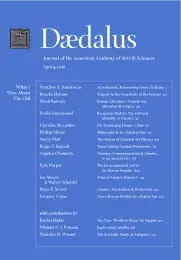The Scientific Study of Antiquity
Breakthroughs in archaeological science, combined with new approaches to interpreting classical texts, have begun to deliver major new insights into the physical realities and mentalities of the classical world. This short essay introduces some of these scientific advances, and argues that profiting from them requires a robustly interdisciplinary skill set.
Sudden dramatic breakthroughs in archaeological science, intertwined with new approaches to the understanding of classical texts and of depictions in various media, promise major new insights into both the physical realities and the mentalities of the classical world. DNA analysis of humans, animals, and pathogens; strontium isotope analysis of movements of individuals over the course of their lives; source analysis of clays and metals; plus technical studies of the chaîne opératoire of pottery manufacture establishing whether the inspiration, the pot, or the potter moved illustrate the rapid advance of archaeological science. A recent DNA study of a corpse from the time of Justinian revealed a pathogen of the same strain of bubonic plague as that which ravaged Europe from AD 1347–1351. Holistic analysis of the 430–426 BC burials in the Kerameikos of Athens during the Great Plague, including DNA and strontium isotope analysis, paleopathological and histological analysis, dietary pattern and dental microwear studies, plus calculus biomolecular and biodistance analysis will add much new information, while new approaches to the study of texts and funerary rituals will shed light on how the survivors in classical Athens understood and reacted to the disaster. Understanding how societies respond to catastrophes is as relevant to our likely future as to our comprehension of ages past.
The study of the fifteen hundred skeletons from the rescue excavation of the recently discovered cemetery in the deme of Phaleron in Athens, covering the period c. 750–470 BC, some with hands bound and showing evidence of torture before death, combined with the study of the pottery and other objects buried with the bodies, will provide a vast amount of new information about the history of Athens, including the identity, behavior, and beliefs of its inhabitants. In all such interdisciplinary efforts, a thorough grounding in the relevant texts and archaeological evidence is essential to avoid error and understand the historical significance of the information recovered. Similarly, the very recent presentation of strong scientific evidence regarding the burial of Philip II of Macedon in Tomb I rather than Tomb II at Vergina, accompanied by what are believed to be the bodies of his wife and newborn daughter who, although murdered after Philip’s death, are now thought to have been interred beside him, sheds dramatic new light on the dynasty that produced Alexander the Great.
The wealth of new categories of data becoming available and new approaches to the interpretation of the past will require interdisciplinary skill sets. A number of universities are rising to the challenge. For example, Sheffield University has long combined the study of archaeology with archaeological science; Cambridge University, at the behest of its vice chancellor, is considering how the new age of the storage and organization of “big data” can be brought to bear on the vast amount of material recovered by archaeological excavation; Harvard University has begun a program on the Science of the Human Past (SoHP) and entered into a collaboration with MIT and the Max Planck Institute in Jena to study ancient DNA; and the University of Arizona has created a new interdisciplinary program via a Center for Mediterranean Archaeology and the Environment (CMATE) offering joint degrees for comajors in one area of Mediterranean archaeology and one field of archaeological science. The state-of-the-art Laboratory for Archaeological Science will open this spring at the American School of Classical Studies at Athens. The future belongs to those prepared to cross narrow academic boundaries. Interdisciplinarians, arise!
